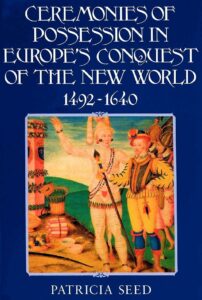Book review: Ceremonies of Possession in Europe’s Conquest of the New World, 1492 – 1640
In Ceremonies of Possession in Europe’s Conquest of the New World, 1492 – 1640, Patricia Seed explores how various European nations – English, French, Spanish, Portuguese, and Dutch – used different methods to claim possession of the New World. Using a comparative framework allows Seed to show how each developing European national culture played a key role in formulating and determining legitimacy as well as authority to claim the New World. By using sources of everyday life, language, and legal codes, Seed nicely explains each country’s approach to the New World, interactions with Indigenous peoples, and how each used this to consolidate power and control over their respective colonies as well as contesting each other’s claims.
According to Seed, each nation had its own way of claiming rightful possession of the newly found lands based upon their past cultural histories and experiences. Simply, the act of discovery was not enough to ensure a ‘discovering’ nation’s claim to ‘new’ lands. She dedicates a chapter to each country.
Chapter 1 discusses English understanding of possession. Seed illustrates how the English argued that physical occupation – fort, house, fenced fields – constituted ownership and sovereignty.
According to Chapter 2, the French relied on ceremony based on the consent of Indigenous peoples summarily gathered to witness the event. In 1534, Cartier erected a cross, offered a speech in French to the assembled Indians who understood Saint Laurence Iroquoian, and claimed consent.
Chapter 3 explores how the Spanish system evolved to ensure the legitimacy and legality of their claims on speech – the requerimiento. Upon landing, Spanish adventurers were required to read aloud a document – the requerimiento – in Spanish, often to an empty forest or without a translator if people were present. In short, Spain based its claims on a speech.
Seed in Chapter 4 discusses how the Portuguese drew on their European, Arabic, and Jewish past to develop its own legal rationales for claiming. In other words, the Portuguese based their claims on knowledge, technology, and their pioneering of the routes to ‘new’ lands.
Finally, in Chapter 5, Seed turns to the Dutch method of claiming possession. Seed argues that the Portuguese idea of what constituted a legitimate claim reflected and referenced Portuguese understandings while adding the notion that to claim something required a naming of it as well as commerce. Simply, trade and regular sailing between named ports constituted legitimate possession. According to Seed, each European nation viewed their idea of possession as legitimate while contesting their competitors’ claims to legitimate legal possession.
Ceremonies of Possession is a fascinating read about how legitimating possession played out amongst the colonizing powers. It adds greater breadth and depth to the understanding of the development of the Western European Christian legal theory known as the Doctrine of Discovery. It also adds nuance and context by ably showing that while European claims to possession may have shared some common cultural and historical ancestry, each claim varied greatly based on the unique cultural experiences and developing nationalisms within England, France, Spain, Portugal, and the Netherlands. The work is also important simply because efforts to define and promote legitimate possession created the modern world.
Overall, the book is straightforward, easy to follow, and well written. If you are interested in learning more about Ceremonies of Possession in the age of discovery and how developing national cultures influenced the arguments surrounding new world conquests, I highly recommend this book.
Patricia Seed, Ceremonies of Possession in Europe’s Conquest of the New World, 1492 – 1640. New York: Cambridge University Press, 1995.
ISBN: 978-0521497572



